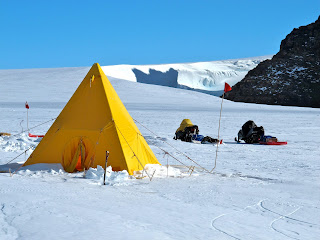We had no scheduled air support on Thursday (16 Dec) so we took advantage of the reasonable weather to sample a moraine in the next valley over at the head of the Argosy Glacier. It was cold and there was some wind and blowing snow, but it was clear and sunny and we had good luck collecting a wide variety of interesting clasts as was the case the day before.
The Argosy Glacier is in the next valley over to the west--around the big wind scoop to the right. This wind scoop is an extraordinary feature with very steep walls of blue ice well over 100 feet high. The presence of wind scoops on either side at the head of the Ascent Glacier indicates that strong winds off the polar plateau is a persistent feature here (the day this picture was taken—not Dec 16--the winds were light). Our route was up the middle of the Ascent glacier and around to the right because crevasses were seen closer to the wind scoop.
Our comfort station (Scott tent) in the foreground.
Although it looks close in this photo, the wind scoop is over a mile away from camp. When looking at the terrain here from a distance it looks like it would be easy going on the skidoos—that you could open up the throttle and cover some large distances quickly. Unfortunately, this is not the case. The wind blown snow is exceptionally hard and the snow machines go over every bump rather than ride down through them. The scalloped blue ice is much harder to go over and require slow speeds. In addition, we have 3 snowmobiles for 5 people, and two people have to ride in the sleds behind the snowmobiles. Any significant speed would rattle them quickly to pieces. All of this means that it is slow going in this terrane and not very pleasant if you are in the back of the sled.
We sampled the glacial clasts on the wind-swept blue ice on the polar plateau side of the Argosy Glacier.
The crew takes an initial inventory of clasts at the Argosy site. It was cold with a persistent wind blowing off the polar plateau—a common theme here.
Wind-swept glacial clasts in the blue ice.
Snow blowing across the clast-spotted blue ice.
Mark Fanning scouring the glacial deposits for interesting and different clasts.
A view from the top of the Argosy Glacier. Interestingly, we saw a fair number snowmobile tracks on the windblown hardpack snow here, despite a wind that blows nearly constantly. There had not been anyone in this area this year, which indicates how some signs of human activity can last an extraordinary long time in places in Antarctica.
Another view of the Argosy Glacier showing an end moraine part of the way down the valley and the glacier flowing off to the right in the background.
On the way back to camp we went to a small nunatak at the head of the Ascent Glacier. There was a PoleNet geophysical station on the nunatak. The solar and wind power for the battery pack powering the equipment is shown here. One of the little wind generators on the right top had been ripped off by high winds some time in the past.
Looking at the basement rocks on the South end of the nunatak. The blue ice of the southern edge of polar plateau is just beyond the nunatak. Further in the background is the polar plateau. There is nothing but ice (mostly snow covered) from here to the South Pole (and beyond).
A view of our humble little camp from near the head of the Ascent glacier.
Back in the Arctic Oven at the end of the day. Dylan and John enjoy a cup of tea while Mark works on dinner.













No comments:
Post a Comment